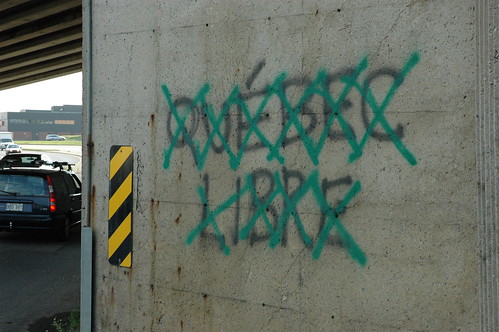“Two months ago Canadians voted in a general election. They made a clear choice.” — “And they [the voters] certainly did not give either the Liberals or the NDP a mandate to govern with the Separatists, the very people who want to destroy Canada.”
– Jim Prentice, Conservative Party MP, Calgary Centre-North, emphasis mine (full text)
“With less than two months since the return to power of the Conservative Party, the Liberals, NDP and Quebec separatists, have plotted to overrule the democratic choice of Canadians by forming a coalition lead by Stephane Dion, to replace the duly elected Conservative government of Stephen Harper.”
– Rob Anders, Conservative Party MP, Calgary West, emphasis added (full text)
“Please help us make it clear that this is NOT what Canadians voted for on October 14 by signing and circulating the attached petition.”
– Rick Casson, Conservative Party MP, Lethbridge, emphasis mine (full text)
It’s pretty clear that conservative MPs know that Canadians should get a legal government which follows the ideals that the majority of Canadians voted for— and one that doesn’t want to see Canada split with Québec.
I have news for you, Conservative MPs. You are MAKING the case for a coalition government.
FACT: The majority of voting Canadians, almost 62%, DID NOT VOTE FOR A CONSERVATIVE PARTY GOVERNMENT.
The chart shows Conservatives won more votes than any other single party. It also shows that a larger majority of Canadians voted for the alternatives.
This next chart demonstrates the seat distribution between the parties.
Notice how even though the Conservatives got 38% of the vote, because of the way our system is setup, they got 47% of the seats. That’s a difference of nearly 10% between the way Canadians voted and the power given to the Conservative Party. Doesn’t sound very democratic, does it?
That’s the system we have in Canada; Conservatives took a minority government and are the legal governing party. However, it’s possible to lose that status, legally.
Canadians vote for an MP in their own riding. Unlike our American counterparts, we don’t vote for a President, but our leader, the Prime Minister, is chosen when MPs gets together with other like-minded MPs, choose who should lead their party, and hold more seats than any other group of like-minded MPs (ie. other parties). If the Prime Minister maintains the confidence of the House of Commons then he gets to remain Prime Minister.
If the House has a vote of confidence, and the party in power loses, then it’s up to the Governor General to call an election or— (and this is where things get interesting), she can decide to allow the other MPs to form a coalition government—two or more parties working together to govern and though not officially combining into a single party, agreeing to set aside their differences.
In order for the NDP and Liberals to combine and form a successful coalition government, they need the help of the Bloc Québécois, without them they only hold 114 seats. With the help of the Bloc’s 49 seats, it gives the coalition a total of 163 seats and enough power (53% of the seats) to decide that they are not happy with Stephen Harper as Prime Minister.
As a combined force, the progressively minded parties have the power to run government the way most Canadians want. Since a minority government, headed up by the Conservative Party, was also elected in 2006, one might wonder why propose a coalition now? Primarily because of some radical changes the Harper government was proposing to make to the way government operates and a lack of action on addressing the global economic recession, but also for many other reasons.
Harper realizes the danger he’s in of losing control, so one of the fear mongering techniques that he and other members of the Conservative Party have been propagating is that the coalition government is giving too much power to “THE SEPARATISTS”.
The agreement that the Bloc has made with the Liberal-NDP coalition DOES NOT grant them any cabinet seats. Thus they’ve effectively agreed to take sovereignty off the table for the next 18 months. Note that, even if that weren’t the case, support for the separatist movement in Quebec is extremely soft right now.
So if there really isn’t a danger of Quebec separating, or reviving a separatist movement, then what does the proposed coalition government mean for Canada?
- The war in Afghanistan – The NDP, Liberals, and Bloc each campaigned on policies to end combat missions in Afghanistan. Conservatives (when they finally got around to releasing their campaign plans a week before election) have decided to “stay the course”.
- The Economy – The NDP, Liberals, and Bloc want to follow the lessons learned in the Great Depression (think Keynesian economics) while the Conservatives prefer a laissez-faire approach, essentially deciding to wait things out.
- The Environment – The NDP, Liberals, and Bloc all campaigned on platforms of attempting to meet the Kyoto Accord targets. The Conservatives have never shown interest in protecting the environment and refuse to consider the world’s long term future.
When the Conservative Party demands that Canadians deserve the government they voted for, I agree.
When the Conservative Party demands that Canada’s leadership follow the ideals that the majority of Canadians voted for, I agree.
When the Conservative Party demands that we watch carefully to monitor separatist sentiment, do our best not to encourage it, and attempt to resolve conflicts as they arise, I agree.
But when the Conservative Party claims that the proposed coalition government does not also agree with all these things, it is more than being disingenuous, it’s an outright lie.
